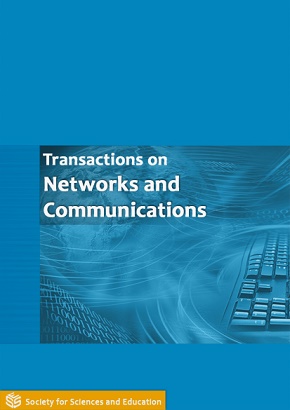Regularities in the social network’s user distribution by the number of mutual contacts
DOI:
https://doi.org/10.14738/tnc.75.7552Abstract
This paper describes a study in which the pattern of distribution of the number of friends among users of the Vkontakte social network among residents of eight large cities of the CIS (Moscow, St. Petersburg, Almaty, Novosibirsk, Tashkent, Kiev, Yekaterinburg, Pavlodar) was studied. Experimental data show that this distribution is of a similar nature for all selected cities. A semi-empirical model was built, on the basis of which an explicit form of theoretical dependence was obtained, describing the nature of the distribution of the number of mutual contacts (“friends”) of users of social online networks. It is shown that this theoretical dependence agrees with satisfactory accuracy with experimental data for a sufficiently large sample of cities. It is established that the Dunbar number, which is included in the dependencies considered as a control parameter, is a characteristic of the communication environment of each specific city and correlates with the population of the city.
References
(1) Chen W., Wang C., Wang Y. (2010). Scalable influence maximization for prevalent viral marketing in large-scale social networks. In Proceedings of the 16th ACM SIGKDD international conference on Knowledge discovery and data mining. ACM. P. 1029-1038.
(2) Doyle S. (2007). The role of social networks in marketing. Journal of Database Marketing & Customer Strategy Management. Т. 15. №. 1. P. 60-64.
(3) Stelzner M. (2014). 2014 Social Media Marketing Industry Report. Social media examiner. P. 1-52.
(4) Chaffey D. (2016). Global social media research summary 2016. Smart Insights: Social Media Marketing.
(5) Ilyashenko S.B. (2016). Social networks internet as a tool to improve e-commerce. In Proceedings of the International Scientific and Practical Conference. P. 105-107.
(6) Hunter E., Pernik P. (2015). The challenges of hybrid warfare. International Centre for Defence and Security, 2015.
(7) Klausen J. (2015). Tweeting the Jihad: Social media networks of Western foreign fighters in Syria and Iraq. Studies in Conflict & Terrorism. Т. 38. №. 1. P. 1-22.
(8) Kamalipour Y.R., Friedrichsen M. (2017). Introduction: Digital Transformation in a Global World. Digital Transformation in Journalism and News Media. Springer, Cham. С. 1-4.
(9) Sergeev I.V. (2015). Social networks on the Internet as a means of implementing operations of information and psychological warfare. International Scientific Research Journal. №. 9(40) Part 4. P. 101-104.
(10) Chernova, T.A., Slepovronskaya, K.Yu. (2015). Historical memory in the information war. How are social networks used in the ideological confrontation between Ukraine and Russia. Philosophical Sciences. №. 5. P. 16-
(11) Zheltukhina М.R., Pavlov P.V. (2016). Social network “Facebook” in the XXI century: from the communication tool to the information war tool. Philology. Theory and practice. №. 7-3. P. 89-93.
(12) De-Marcos L. et al (2014). An empirical study comparing gamification and social networking on e-learning. Computers & Education. Т. 75. P. 82-91.
(13) De-Marcos L. et al (2016). Social network analysis of a gamified e-learning course: Small-world phenomenon and network metrics as predictors of academic performance. Computers in Human Behavior. Т. 60. P. 312-321.
(14) De Meo P. et al (2017). Combining trust and skills evaluation to form e-Learning classes in online social networks. Information Sciences. Т. 405. P. 107-122.
(15) Bukayeva А.А., Magzumova А.Т. (2015). The use of social networks in the educational process. Innovations in Science. №42 p. 120-126.
(16) Kalmykova S.V., Krasnoshchekov A.V. (2017). Approaches to e-learning organization through the social networks. Modern education: content, technology, quality. Т. 1. P. 195-198.
(17) Makhmutova M.V., Makhmutov G.R. (2015). Models and platforms for the implementation of mass open online courses. Modern information technologies and IT education. Т. 1. №. 11. P. 486-496.
(18) Kurzaeva L.V., Grigoriev A.D. (2015). Mass open online courses: essence, specific characteristics. New information technologies in education. P. 250-253.
(19) Bremer C., Weiß D. (2013). How to analyze participation in a (C) MOOC?. Univ.-Bibliothek Frankfurt am Main. P. 992-1002.
(20) Khalil M., Brunner H., Ebner M. (2015). Evaluation grid for xMOOCs. International Journal of Emerging Technologies in Learning (iJET). Т. 10. №. 4. P. 280-314.
(21) Colas J.F., Sloep P.B., Garreta-Domingo M. (2016). The effect of multilingual facilitation on active participation in MOOCs. The International Review of Research in Open and Distributed Learning. Т. 17. №. 4. P. 4-11.
(22) Dunbar R.I.M. (1993). Coevolution of neocortical size, group size and language in humans. Behavioral and brain sciences. Т. 16. №. 4. P. 681-694.
(23) Dunbar R. (1998). Grooming, gossip, and the evolution of language. Harvard University Press.
(24) Dunbar R.I.M. (2009). The social brain hypothesis and its implications for social evolution. Annals of human biology. Т. 36. №. 5. P. 562-572.
(25) Shultz S., Dunbar R.I.M. (2012). The social brain hypothesis: an evolutionary perspective on the neurobiology of social behavior. I Know What You Are Thinking: Brain Imaging and Mental Privacy. P. 13-28.
(26) Gilyazova А.А. (2014). On the estimation of the number of Dunbar and its influence on the interaction of users in the social network Facebook. In XII All-Russia Conference on Control Problems ARCCP-2014. P. 6292-6300.
(27) Chesnokov V.O. (2017). The use of the algorithm for isolating communities in the information confrontation in social networks. Cybersecurity issues. №. 1 (19). P. 37-44.
(28) Katasev A.S., Kirpichnikov A.P., Ramazanova R.I. (2015). Method of analyzing the security of social network accounts from malicious content. Bulletin of Kazan Technological University. Т. 18. №. 18. P.195-198.
(29) Rzayeva M.E. (2015). Evaluation of the effectiveness of special projects in Russian online media through the determination of the price of contact. The media sphere: problems and points of development.






